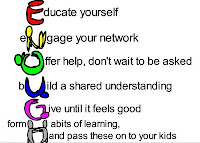I've been sharing pages from printed newsletters that I created in the 1990s in the past few blog articles, along with portions of e-Mail newsletters sent from 2000 to 2010. These show a consistency in the advocacy I've been doing for 30 years, and the need for new leaders to carry this forward for the next 30 years.
Below are two pages from a 1999 newsletter. You can open the PDF at this link.
In this page is a subhead that reads "Building 'social capital' for America's future." in this I wrote about hearing Dr. Robert D. Putnam speak in December 1998 at a UIC Great Cities annual Winter Forum. I wrote that "Dr. Putnam's research shows that "Americans have dramatically deserted the voting booth, the family dining table, the church pew, the union hall, the PTA, and even the bowling league and coffee klatch" over the past 25 years. He suggested that new forms of social interaction must be generated in the coming years.
I countered that "while most forms of social capital have declined, the number of students and volunteers participating in the 5pm-7pm tutor/mentor program sessions held at the Montgomery Ward headquarters in Chicago has increased. While other forms of networking have declined, this program's ability to connect adult volunteers from widely diverse social, ethnic, faith and geographic backgrounds has increased. Programs like this, which connect adults and children in weekly one-on-one and group settings --- where everyone has a shared vision of making life better for the children we serve --- is one of the best investments in social capital, diversity education and workforce preparation any company could invest in today."
I have continued to advocate for organized, volunteer-based, tutor, mentor and learning programs as a form of social capital since 1999. In 2016 I wrote this article, pointing to Putnam's "Our Kids: The American Dream in Crisis" book. It's one of more than 30 articles on this blog that focus on social capital.Once again you can see examples of how I've been using maps.
Under the heading of "MENTORING WORKS, BUT....", I wrote "Communities need a strategy to help mentoring programs recruit, train and retain volunteers, to make sure programs are where they are most needed, and to make sure they receive ongoing funding, so they can stay connected with a child for as long as that child needs their help...even into a career."
They still do.
Open the PDF and read the full article, and the rest of the news that we were sharing in 1999.
I've continued to repeat this call to action over the past 25 years. Below is a graphic I created for this 2016 article.
It's the same message, with a different visual presentation. That's the point of this and other articles that I've been writing. I've been preaching this message of building and sustaining organized, mentor-rich programs that reach K-12 kids in high poverty areas for 30 years.
Yes, there are actually thousands of people calling for support for mentoring and tutoring programs. I point to hundreds of youth-serving programs at this link. Many have sophisticated, far-reaching advertising and PR strategies that call attention to their own programs.
However, I don't find any using maps to focus attention and resources on areas of high poverty within specific geographic regions, or calling on volunteers and donors to support programs in every high poverty area, the way we did from 1993 to 2011. Nor do I find many using visualizations that show long-term support needed in every high poverty area. Or who has piloted a year-round event strategy to help programs grow. Or who have led that strategy for 30 consecutive years.
So, I think I'm unique. In fact, one of my volunteers once accused me of being so far in front of other people with my ideas that no one was able to follow me. That's why I've used my website, blog and visual essays to share ideas.
But I'm just one person. With the help of six other volunteers we created the vision of Cabrini Connections and the Tutor/Mentor Connection in November 1992. We had no source of financial support. We launched the site-based Cabrini Connections in January 1993 with seven volunteers and five teens. We did the planning for the Tutor/Mentor Connection in 1993 and launched it in January 1994.
In the summer of 1993 Montgomery Ward made a multi-year commitment of $40,000 a year to fund our work and donated an entire floor of its corporate tower in Chicago for our operations. In total that year we raised only $50,000 in cash, but the value of donated space and corporate services was much greater.Each year from 1994 to 2000 we raised more money to fund our efforts and raised over $400,000 in 1999. Then Wards went out of business and we lost their financial support and donated space and services. To stay connected to the kids we were were working with we had to rent space in the Cabrini Green neighborhood.
This increase in expense and loss of income came as we endured the dot.com financial meltdown in 2000, and then entered 2001, and the 9/11 tragedy that led to a drastic reduction in funds available to us. We cut expenses, such as ending our print newsletters and printed directory and moving almost entirely to a web-based communications strategy.
By 2007 we had rebuilt our donor base and were receiving contributions as large as $50,000. Then the financial markets collapsed, and in 2009 and 2010 we struggled. That led to my leaving Cabrini Connections in mid 2011 and forming the Tutor/Mentor Institute, LLC to continue the Tutor/Mentor Connection in Chicago and help similar intermediaries grow in other cities.
I say all this to emphasize that we never had much money for advertising and public relations. Our newsletters never were sent to more than 12,000 people, and then only three or four times a year.
Too little to change the world.
A couple of weeks ago I published this article showing how I've reached out to universities for the past 30 years for the talent and manpower needed to expand the reach, frequency and impact of the Tutor/Mentor Connection and the ways we were helping our own teens through school and into college and careers.But is has not been enough.
As you look at my printed newsletters from the 1990s you see a problem that persists around the country in 2024, and will continue, unless more people adopt an information-based strategy like I've piloted and devote their own time, talent and resources to leading it for the next 30 years.
It just takes two or three people, with a big commitment (and a major donor) to launch such a program.

















































